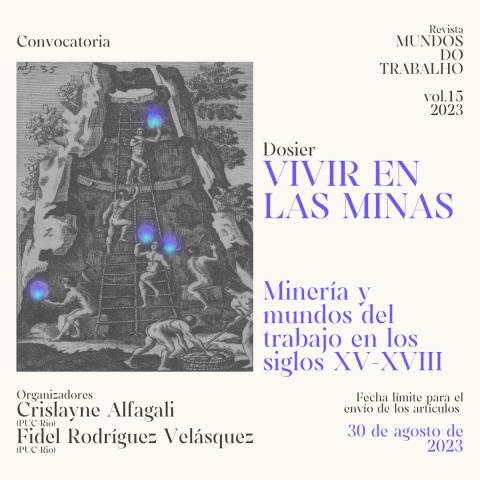
* ENGLISH BELOW *
Chamada de artigos para dossiê temático da Revista Mundos do Trabalho, volume 15 (2023) https://periodicos.ufsc.br/index.php/mundosdotrabalho
Além de artigos (em português, espanhol ou inglês) em fluxo contínuo, resenhas e entrevistas, Mundos do Trabalho está com chamada aberta de artigos para o dossiê temático indicado abaixo.
Título do dossiê: Vivendo nas minas: mineração e mundos do trabalho nos séculos XV-XVIII
Organização: Crislayne Alfagali (PUC-Rio) e Fidel Rodríguez Velásquez (PUC-Rio)
Submissões inéditas em português, inglês ou espanhol até o dia 30 de agosto de 2023.
O trabalho e os trabalhadores estão no centro da história da construção do mundo na época moderna. A mineração e a vida nas minas ocupam uma parte importante dessa história. Entre os séculos XV e XVIII, metais como o ouro e a prata foram cruciais para motivar e financiar empresas colonizadoras, bem como para possibilitar a circulação de trabalhadores, conhecimentos, técnicas e tecnologias em um mundo cada vez mais conectado.
São conhecidos os números concretos do mercado global de mineração, as políticas imperiais/coloniais que tentaram regular estes processos, bem como os locais onde os subprodutos mineiros foram integrados nas cadeias de consumo. Ao contrário, as experiências de pessoas comuns que trabalharam e viveram nas minas continuam sendo um ângulo a ser consolidado. Por isso, este dossiê se interessa especialmente por uma história social da vida nas minas que coloca os trabalhadores no centro do debate.
O convite é para refletir sobre as conexões e comparações entre o trabalho nas minas em diversas regiões do globo e, ao mesmo tempo, trazer à luz os trabalhadores das minas, suas vidas e relações cotidianas. Uma perspectiva que considera processos espaço-temporais mais amplos, analisando as intersecções entre projetos políticos, redes de indivíduos ou trajetórias de vida. Ao recortar os séculos XV-XVIII, busca-se ultrapassar a aparente oposição entre trabalho livre e escravo, voltando para as experiências dos sujeitos históricos escravizados, livres e libertos.
A mineração é um lócus privilegiado de análise dos variados níveis de liberdade no trabalho-não-livre e as formas de coerção em sistemas de trabalho livre. Cabe questionar: como os trabalhadores viveram, foram tratados, remunerados, como eram transportados, como era a sua moradia? Havia uma divisão do trabalho de acordo com gênero, idade e habilidade? Ou ainda, o conhecimento técnico, a destreza em um ofício, ou ser homem, ou mulher eram fatores que diferenciavam suas experiências? Os trabalhos eram sazonais e seguiam que ritmos de produção? E, sobretudo, vale pensar como os trabalhadores refletiam sobre suas experiências, negociavam e resistiam à perda de seus modos de vida e privilégios. Por fim, como comunidades inteiras subsidiam o trabalho nas minas, é preciso compreender como foram afetadas, se as minas alteraram sua capacidade de acumulação e produção.
***
Living in the mines: mining and worlds of labour in the XV-XVIII centuries.
Labour and workers have been central to the history of the early modern world. Mining and life in the mines occupy an important place in this history. Between the 15th and 18th centuries, metals such as gold and silver were crucial in motivating and financing colonization ventures and enabled the circulation of labour, knowledge, skills, and technologies in an increasingly connected world. The specific figures of the global mining market, the imperial or colonial policies that sought to regulate these processes, and the places where mining by-products were integrated into consumption chains are well known. The experiences of the ordinary people who worked and lived in the mines, on the other hand, remain an aspect to be explored in depth. For this reason, this dossier is particularly interested in a social history of life in the mines that places the workers at the centre of the debate.
The aim is to reflect on the connections and comparisons between work in the mines in different regions of the world, while at the same time shedding light on the mine workers, their lives, and their daily relationships. A perspective that considers broader spatio-temporal processes and analyses the intersections between political projects, networks of individuals, or life courses. By covering the fifteenth to eighteenth centuries, we aim to overcome the apparent opposition between free and slave labour and focus on the experiences of enslaved, free, and liberated historical subjects.
Mining is a privileged site for analysing the different levels of freedom in unfree labour and the forms of coercion in free labour systems. It is worth asking: how did workers live, how were they treated, how were they paid, how were they transported, what was their accommodation like? Was there a division of labour according to gender, age, and skills? Or was even technical knowledge, manual dexterity, or membership in a particular occupational group a factor that differentiated workers' experiences? Were the jobs seasonal, and did they follow which production rhythms? And above all, it is worth reflecting on how workers thought about their experiences, negotiated, and resisted the loss of their way of life and privileges. Finally, given that whole communities facilitated work in the mines, it is necessary to understand how they were affected and how the mines changed their capacity to accumulate and produce.
Deadline: 30/08/2023
